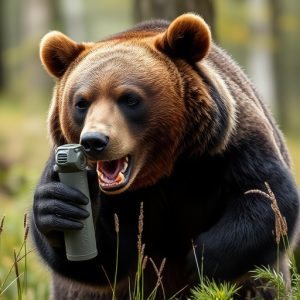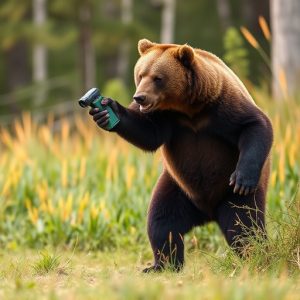Mastering Alaska Bear Spray: Fog Pattern, Storage & Application
Maximizing bear spray effectiveness requires understanding its fog pattern and proper storage temper…….
Maximizing bear spray effectiveness requires understanding its fog pattern and proper storage temperature (40°F-75°F/4.4°C-23.9°C) to prevent degradation from heat or cold. Shake the can before use, aiming for a 30-foot mist, and store it between -20°F and 85°F (-29°C and 29°C) in cool, dry places out of direct sunlight for optimal performance against both brown and black bears.
“In Alaska’s rugged wilderness, understanding bear spray fog pattern is vital for hikers and outdoor enthusiasts. This comprehensive guide unravels the science behind this potent self-defense tool. We explore optimal conditions, including the proper temperature for bear spray storage, to ensure maximum efficacy. From application techniques to debunking common misconceptions, learn how to leverage bear spray effectively during encounters with these majestic yet potentially dangerous beasts.”
- Understanding Bear Spray Fog Pattern and its Efficacy
- Ideal Temperature Conditions for Optimal Performance
- Storage Considerations: Keeping Your Spray Safe
- Application Techniques for Maximum Protection
- Common Misconceptions About Bear Spray Effectiveness
Understanding Bear Spray Fog Pattern and its Efficacy
Understanding the bear spray fog pattern is crucial for ensuring its effectiveness in real-world scenarios. When deployed, bear spray creates a fine mist or fog that floats in the air, covering a wide area. This unique pattern allows for maximum exposure to bears’ sensitive eyes and respiratory system, disabling them temporarily without causing permanent harm. The fog’s range and persistence depend on various factors, including the can’s nozzle design and the environment’s conditions such as temperature and wind speed.
Proper storage temperature is also essential to maintain bear spray’s performance. Extreme heat or cold can degrade its potency over time. Ideal storage temperatures typically range between 40°F and 75°F (4.4°C to 23.9°C). Following the manufacturer’s guidelines for both usage and storage conditions guarantees that your bear spray remains effective when you need it most, ensuring your safety in Alaska’s diverse wilderness.
Ideal Temperature Conditions for Optimal Performance
The optimal performance of bear spray is highly dependent on temperature conditions. For maximum effectiveness, it’s crucial to store and use bear spray within a specific range. The ideal temperature for bear spray storage is between 50°F (10°C) and 70°F (21°C). Temperatures outside this range can affect the spray’s concentration and fog pattern. Extreme heat or cold may cause the spray to become less potent or even solidify, reducing its ability to reach and deter bears effectively.
When carrying bear spray while hiking or camping in Alaska, it’s essential to keep it accessible and consider the environmental temperature. During colder months, ensure your spray remains in a protective case or container to prevent freezing. In warmer conditions, be mindful of leaving the spray in direct sunlight for extended periods, as this can also cause potential degradation. Maintaining the proper temperature for bear spray storage is a simple yet vital step in ensuring its reliability when facing potentially dangerous bear encounters.
Storage Considerations: Keeping Your Spray Safe
When storing bear spray, temperature plays a crucial role in maintaining its effectiveness. It’s recommended to keep your spray in a cool, dry place, ideally between 40°F and 85°F (4°C to 29°C). Extreme temperatures can degrade the active ingredients over time, reducing the spray’s potency. Avoid storing it in direct sunlight or near heat sources, as these conditions can accelerate the breakdown of the chemicals.
Proper storage also involves keeping the spray out of reach from children and pets. Ensure it’s locked away in a secure cabinet or container to prevent accidental discharge. Additionally, keep your bear spray away from other chemicals or products that could react with its components, further compromising its safety and performance.
Application Techniques for Maximum Protection
When applying bear spray, understanding the fog pattern is key to maximum protection. For best results, ensure the can is properly oriented – nozzle down – before shaking vigorously for 10-15 seconds. This creates a fine mist that expands up to 30 feet, allowing you to cover your body and vital areas like the face and neck. Targeting the bear’s eyes, nose, and mouth can significantly reduce its aggression.
Remember, the proper storage temperature of -20°F to 85°F (-29°C to 29°C) is crucial for maintaining the effectiveness of your bear spray. Extreme temperatures can cause the product to solidify or degrade, reducing its performance when you need it most. Always store your bear spray in a cool, dry place, out of direct sunlight, and keep it easily accessible in case of an encounter.
Common Misconceptions About Bear Spray Effectiveness
Many people hold misconceptions about bear spray, doubting its effectiveness as a safety measure in wild encounters. One common misunderstanding is that bear spray only works on brown bears, ignoring its efficacy against black bears, which are more prevalent in certain regions. Another misconception is that the spray can kill or seriously harm a bear, which is not true; it’s designed to disable temporarily and give you time to escape.
Moreover, there’s a belief that cold weather renders bear spray useless, but this isn’t entirely accurate. Bear spray remains effective across various temperatures, including cold conditions, as long as it hasn’t frozen or been exposed to excessive heat. The key factor is the proper storage temperature, recommended around 50-120°F (10-49°C), which ensures optimal performance when you need it most.
In conclusion, understanding the guard Alaska bear spray fog pattern and optimal application techniques is key to ensuring maximum protection in bear country. Ideal storage conditions, specifically the proper temperature, are equally vital to maintain the spray’s effectiveness. By grasping these concepts and adhering to best practices, outdoor enthusiasts can better navigate and reduce risks when encountering bears. Remember, knowledge and preparation are essential tools for a safe and enjoyable adventure in Alaska’s wild landscapes.


